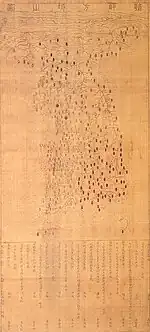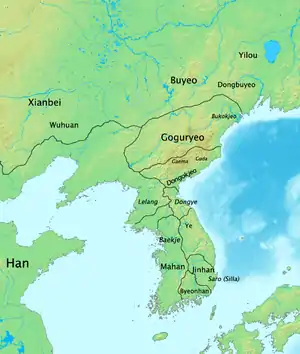Eastern Ye
Ye or Dongye (Korean pronunciation: [toŋ.je]), which means the Eastern Ye, was a Korean chiefdom which occupied portions of the northeastern Korean peninsula from roughly 3rd-century BC to around early 5th-century AD. It bordered Goguryeo and Okjeo to the north, Jinhan to the south, and China's Lelang Commandery to the west. Today, this territory consists of the provinces of South Hamgyŏng and Kangwon in North Korea, and Gangwon in South Korea.
| Ye | |
| Hangul | 예 |
|---|---|
| Hanja | |
| Revised Romanization | Ye |
| McCune–Reischauer | Ye |
| History of Korea |
|---|
 |
| Timeline |
|
|
History

Ye appears in history as a vassal state of Goguryeo. In early 5th-century, however, King Gwanggaeto the Great of Goguryeo annexed Ye, leading to Goguryeo's domination of the entire northern portion of the Korean peninsula and most of Manchuria. A small part of Ye in the south was absorbed into Silla.
Haslla (何瑟羅) (present-day Gangneung),[1] Bulnaeye (不耐穢) (present-day Anbyon County), Hwaryeo (華麗) (present-day Kumya County) are known as the countries established by Ye.[2][3][4][5] According to a recent study, Siljikgok (present-day Samcheok) is also seen as an area of the ye culture.[6][7]
According to the Book of the Later Han and Records of the Three Kingdoms, fellow soldiers are as good at infantry as Okjeo. They had a sense of homogeneity with Goguryeo. It is said that it used 3 丈 long spear as a weapon and supported the army as a vassal of Goguryeo.[8][9][10]
People and culture
The Ye people considered themselves to be the same people as the people of Goguryeo, and shared their language and ethnic origins with the people of Okjeo and Goguryeo. This may indicate that Dongye also shared a common origin with Buyeo and Gojoseon. The population was recorded to be 280,000 families.
Very little information about Ye has survived; most of the extant information comes from the discussion of the Eastern barbarians in the Chinese Records of Three Kingdoms. The custom of "Mucheon" (무천, 舞天), a festival of worshipping heaven through song and dance in the 10th month, is mentioned in some records. This appears to have been closely related to the Goguryeo festival of Dongmaeng, held at the same time of year, which also incorporated martial displays. The people worshiped the tiger as a deity.
The economy of Ye was based primarily on agriculture, including sericulture and hemp cultivation.[11] The Mucheon festival was largely aimed at securing a good harvest in the coming year. Their agriculture appears to have been well-organised at the village level. Ye law meted out stiff penalties for those who encroached on communal land.
They have no sovereign chief... Their elders have long considered that they are of the same stock as the Goguryeo. Sincere by nature they keep their desires to a minimum, have a sense of shame, and do not beg for alms. In language, usages, and customs they are in general the same as the Goguryeo, but in their clothing there are differences. Men and women both wear pleated collars, and the men plait silver flowers several inches wide for adornment... Their custom is to give great importance to mountains and rivers, each of which has certain parts into which people are not permitted to wade indiscriminately. Members of the same clan do not intermarry. They have many superstitions and taboos: in the event of illness or death, they always abandon their old dwelling, rebuild, and resettle... They also sacrifice to the tiger as to a divine being... They make spears three zhang in length, sometimes carried by three men at once. They are capable foot soldiers; the "sandalwood bow" of Lelang comes from their land.[12]
Notes
- It was originally capital of Ye (濊). It belonged to the Wiman Joseon in 129 BC. NamRyeo, the leader of Yemaek, betrayed the Wiman Joseon and belongs to the Han Dynasty in 128 BC. With the establishment of Four Commanderies of Han, it was reorganized into Lintun Commandery(108 BC). Become independent in 82 BC. In AD 60, the Siljik king fled to Uljin when Haslla attacked the Siljikgok.
- 三國史記(Samguk sagi) 卷第一 新羅本紀 第一 儒理 尼師今(Yuri of Silla) > In AD 40, September, people from Hwaryeo and Bulnaeye joined forces to lead cavalry and invade the northern frontier. Maek was waiting in the west of the curved river using a military force and struck and defeated. The king rejoiced and established friendly relations with the Maek.
- It is not clear whether this Maek means Baekje, Goguryeo, or Malgal, which often appears in the Samguk Sagi.
- Records of the Three Kingdoms
- Book of Han
- 박지희. 2016, 「실직국의 역사고고학적 연구」, 가톨릭관동대학교 교육대학원
-
- (A)study on the Siljikguk by the historical & archaeological methods
- (3丈 = 6.9m)
- 三國志 (Records of the Three Kingdoms) 魏書 (Book of Wei) 東夷傳 (Volume 30) - 濊南與辰韓, 北與高句麗·沃沮接, 東窮大海, 今朝鮮之東皆其地也. 其耆老舊自謂與句麗同種. 其人性愿慤, 少嗜欲, 有廉恥, 不請句麗. 言語法俗大抵與句麗同, 衣服有異. 男女衣皆著曲領, 男子繫銀花廣數寸以爲飾. 漢末更屬句麗. 常用十月節祭天, 晝夜飮酒歌舞, 名之爲舞天, 又祭虎以爲神. 作矛長三丈, 或數人共持之, 能步戰. 樂浪檀弓出其地. 其海出班魚皮, 土地饒文豹, 又出果下馬. The south side of the ye (濊) is Jinhan, and the north side is Goguryo and Okjeo. There is a large sea to the east, and the eastern part of the GoJoseon (朝鮮) is all the land. The old people have long been said to be the same kind of Goguryo themselves. People's temper is restrained and sincere. They did not beg for pleasure, less greed, less humility, shyness. Language, law and customs are largely the same as Goguryo and clothes are different. Both men's and women's clothes are clearly curved, and men decorate themselves with silver belts. At the end of Han Dynasty era, ye was once again part of Goguryeo. Ye always held ritual in October, and drank, sang and danced day and night, it was called Mucheon. They also hold ritual for tigers as gods. The spear is 3 jang (丈) length, and several people hold it together. they are good at infantry. Dangung (bow) come out of the land belongs to Lelang, Seal leather comes out of the sea, and there are leopards and little horse.
- Partial Quotation
- Records of Three Kingdoms (San guo zhi): 麻布,蠶桑作綿, 曉候星宿,豫知年歲豐約. See Wikisource:zh:三國志/卷30. See also Korean Britannica entry.
- Lee 1992, p. 16-17.
Bibliography
- Lee, Peter H. (1992), Sourcebook of Korean Civilization 1, Columbia University Press